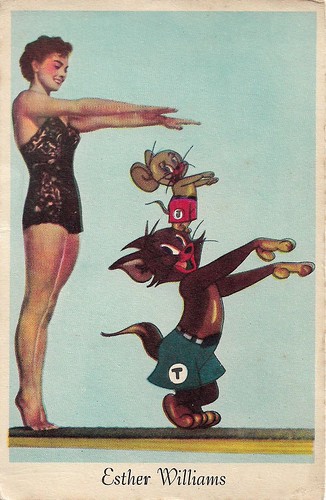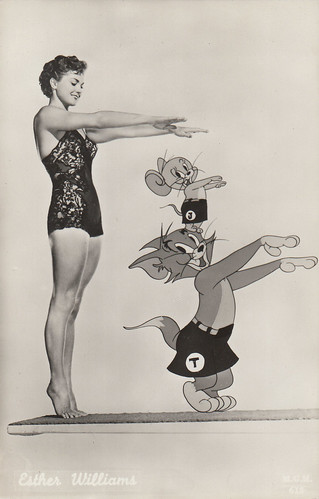
Vintage collector card. Photo: M.G.M. Esther Williams and Tom and Jerry in Dangerous When Wet (Charles Walters, 1953).

Dutch postcard by Gebr. Spanjersberg, Rotterdam / Antwerpen, no. 05.1288. Image: Metro-Goldwyn-Mayer, Inc., 1978 / Televideo Holland B.V., Naarden.
114 delightful cat-and-mouse cartoons
The history of Tom and Jerry is usually divided into seven periods: Hanna-Barbera period (1940-1958), Gene Deitch period (1961-1963), Chuck Jones period (1963–1967), Later Hanna-Barbera period (1975), Filmation Associates (1980), Hanna Barbera Studios (1990–1993) and Warner Brothers (1993-present). The precursor to the series was the animated film Puss Gets the Boot (1940). Like the first 114 episodes, it was produced in the Metro-Goldwyn-Mayer animation studios under the direction of William Hanna (1910–2001) and Joseph Barbera (1911–2006) using classic animation techniques.
Fred Quimby and other senior MGM executives reacted rather cautiously to the screening of the film, even though they had been very impressed by the preliminary versions. When the film was released in cinemas without much advertising, Rudolf Ising was credited as director, while Hanna and Barbera were not mentioned by name in the original version. After the film was nominated for an Oscar, Quimby called the two into his office, explained that MGM did not want to put all its eggs in one basket, and had them work on other characters. It was only when short film expert Besa Short wrote to Quimby asking ‘when the world would see more of these delightful cat-and-mouse cartoons’ that Hanna and Barbera were instructed to work on the characters again.
Now the cat, initially named Jasper, and the mouse (called Jinx by Hanna) needed new names. Studio employees were asked to write pairs of names on pieces of paper, which were collected in a hat. The piece of paper pulled from the hat contained the names Tom and Jerry and came from animator John Carr, who won fifty dollars. Now the studio had to obtain legal permission to name the two characters after the cocktail Tom and Jerry. The characters of the same name from Van Beuren Studios had already been discontinued in 1933. From 1940 to 1958, 114 Tom and Jerry cartoons were produced by the Metro-Goldwyn-Mayer cartoon studio in Hollywood, after which the film studio was closed. At the time, the cartoons, like all animated films of that era, were shown in cinemas. These 114 cartoons are now considered timeless classics and are still very popular worldwide. Seven of them won Academy Awards for Best Animated Short Film, placing Tom and Jerry just below Walt Disney's Silly Symphonies as the animated series that won the most Oscars.
Depending on the animation team and concept, there are stylistically different designs for Tom and Jerry between the first episodes of Tom and Jerry. In the early days, the cat was drawn in a very cute, fluffy and stylised manner, while the mouse was rather chubby and not very expressive. The characters evolved from the realistic style used in merchandising today to the more distinctive forms of 1949, which were again much more abstract. The original series is notorious for its extremely violent gags: Jerry cuts Tom in half, traps his head between a window or a door, sticks his tail in a waffle iron or an electrical socket. Tom uses axes, guns, dynamite, clubs and poison to try to kill Jerry. A running gag is that Jerry hurts Tom while he is not paying attention, and Tom only realises this pain a few seconds later. Tom's body also takes on all kinds of bizarre shapes after these tortures. For example, he is crushed by a heavy cupboard or steamroller and then becomes as flat as an ironing board, only to 'pop' back into shape a few seconds later and furiously chase after Jerry.
The cat is kept by the black housekeeper, Mammy Two-Shoes, who is afraid of mice. In the American original, she speaks with a distinct Southern black accent, mainly appears as an authority figure or punisher, and often comes to harm. A special feature is that in the older films, only the lower half of the drawn humans is shown (from the perspective of a child or an animal). The music and sound effects play an important role in the short films and contribute to the humour and action. Music director Scott Bradley created a mix of jazz, classical and pop music. Tom and Jerry had a guest appearance in the feature film Dangerous When Wet (Charles Walters, 1953). The live-action musical comedy features an animated swimming sequence starring Esther Williams with Tom and Jerry.

Dutch postcard by Uitgeverij Stam BV, Leersum, no. 56, Series 2022. Image: TM & Turner Entertainment Co.

Dutch postcard by Uitgeverij Stam BV, Leersum, no. 56, Series 2022. Image: TM & Turner Entertainment Co.

Dutch postcard by Uitgeverij Stam BV, Leersum, no. 56, Series 2022. Image: TM & Turner Entertainment Co.
A wildly violent cat-and-mouse relationship
In 1960, MGM handed over the production of Tom and Jerry to Rembrandt Films, led by Gene Deitch in Prague, in what was then Czechoslovakia. The result was a series of very cheaply produced and surreal animated films. Three years later, production returned to Hollywood, where Chuck Jones directed new episodes for Sib-Tower 12 Productions until 1967. In 1975, a new Tom & Jerry Show was launched in which the pair interacted on a friendly basis. This was followed by various attempts to revive the old series, but the first 114 cartoons from the period 1940-1957 are generally considered the best and remain the most popular.
The plots of the short films usually revolve around Tom's frustrating attempts to catch Jerry and the wild violence that accompanies this. Both Tom and Jerry are equally mean to each other, but there are just as many moments in the films where they get along reasonably well. This makes it unclear why Tom chases Jerry so often, but the most obvious reasons are probably: their cat-and-mouse relationship, because Tom's mistress orders him to, competition with another cat, revenge after a provocation by Jerry, or pure bullying. Tom sometimes manages to catch Jerry, usually because Jerry allows him to or through sheer luck. In Heavenly Puss from 1949, Tom dreams that he is not allowed into heaven after his death as punishment for wasting his whole life chasing Jerry.
There were numerous attempts to make a Tom and Jerry feature film, primarily in the 1970s, after the successful reruns of the original cartoons and the airings of the new TV animated versions. After 25 years, the odd couple returned to the screen in their first theatrical feature-length animated film, Tom and Jerry: The Movie (1992). It was produced and directed by Phil Roman, with a screenplay written by Dennis Marks, who also scripted some episodes of the then-airing TV series Tom & Jerry Kids. The film features original songs written by Henry Mancini and Leslie Bricusse and a score also composed by Mancini. Although largely mute in the original cartoons, Tom and Jerry are given extensive spoken dialogue for the only time to date. Joseph Barbera, co-founder of Hanna-Barbera Productions and co-creator of the original Tom and Jerry short films, served as the film's creative consultant.
The film tells the story of an eight-year-old girl named Robyn Starling, who enlists Tom and Jerry's help to escape from her evil legal guardian and reunite with her lost and presumed-dead father. The film grossed $3.6 million and received negative reviews. Gene Siskel and Roger Ebert gave the film two thumbs down on Siskel & Ebert. Although they praised the animation style for its faithfulness to the theatrical shorts, neither thought that it was a good idea to give dialogue to the two characters, with Ebert stating that by making the duo talk, "the movie loses the pure comedy of the cartoon shorts where everything depended on situation and action." Additionally, they felt that the film suffered from a lack of slapstick action compared to the shorts, and criticised the story for giving the character of Robyn Starling more screen time than Tom and Jerry.
After years of languishing in development hell, including a live-action film in 2009 and an animated film in 2015, a live-action/animated hybrid film followed, Tom and Jerry / Tom & Jerry (Tim Story, 2021), written by Kevin Costello. Although it utilises 3D computer animation, the production developed software and used other techniques to mimic the look of traditional animation. The film received generally negative reviews from critics and grossed $136 million worldwide on a $50‒79 million production budget. On RogerEbert.com, Brian Tallerico gave the film one out of four stars: "Aggressively mediocre, the updated version of Tom & Jerry (...) is a depressing affair, a film that reminds one of similarly hollow uses of beloved properties like Yogi Bear and The Smurfs. Although at least they knew to focus on their timeless characters. Tom & Jerry barely understands the physical comedy that made the cat and mouse first-round entries in the animated Hall of Fame, focusing instead on a celebrity wedding at a fancy New York hotel and the people who work there. A few sequences of classic T&J comedy aren’t nearly enough to make up for the dull plotting and flat characters in this soulless product, one that will fail equally for adults who grew up on Tom and Jerry, and their kids who have never heard of these characters." The film won a Golden Raspberry Award for Worst Prequel, Remake, Rip-off or Sequel.

Vintage postcard, no. 615. Photo: M.G.M. Esther Williams swam with Tom and Jerry in Dangerous When Wet (Charles Walters, Joseph Barbera (animation sequences), William Hanna (animation sequences), 1953). Collection: Marlene Pilaete.

American postcard by Classico San Francisco, no. 350-013. Image: Turner Entertainment Co. and WMG. Publicity still from Tom and Jerry - The Movie (1992).

British collector card in the Partners series by Victoria Gallery, London, no. 19 in a series of 20. Illustration: Stephen Bennett. Caption: TOM & JERRY. Short cartoons featuring the mean-minded, accident-prone cat and likeable little mouse, Tom and Jerry. The original cartoons were drawn by William Hanna and Joe Barbara in 1937. There were an awful lot of these cartoons made, and some were always winning Academy awards - titles such as The Milky Way, Yankee Doodle Mouse, Mouse Trouble, Cat Concerto and The Little Orphan, as well as quite a few more.
Sources: Brian Tallerico (Roger Ebert.com), Wikipedia (English, German and Dutch) and IMDb.
No comments:
Post a Comment